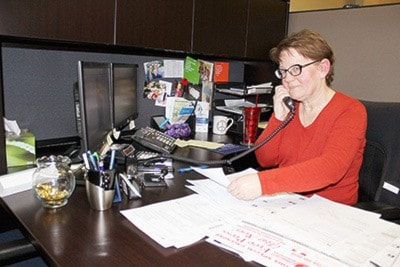Barbara Roden
Free Press
“I’d been thinking about doing this for seven years,” Val Nickless says about becoming a live kidney donor.
“I’d see a story on the news about it, and think that if one of my loved ones needed a kidney and I couldn’t help, I’d hope someone else would donate.”
It was a story she saw 18 months ago, about a young grandmother who needed a kidney, which finally prompted Nickless to donate.
“I decided I’d procrastinated long enough, and during my lunch hour I made the phone call.”
She initially thought she’d make an anonymous donation to someone on the BC Transplant list, and was able to speak with area donors, such as Craig Conklin, who donated a kidney to a friend, and Dianne Dulmage, who donated a kidney to her husband, Shaun.
“I was able to ask questions about how it works and what the recovery is like, so it was good to talk to them.”
Nickless had also been doing some research, and began reading about the Living Donor Paired Kidney Exchange Registry (LDPKER) program.
The program is run by Canada Blood Services, and creates chains of donors and recipients. If someone wants to donate a kidney to a family member or friend, but finds they’re not compatible, they can go on the LDPKER registry.
Using the information on the registry, a chain of up to six pairs of recipients and donors can be put together. Nickless decided to participate in the program, and became part of a chain.
She had been asked how far from home she was willing to travel, and had said within British Columbia or Alberta. In November 2015, she travelled to Alberta to donate a kidney.
The recipient had someone in his or her life who had agreed to donate a kidney but was not compatible, so that person’s kidney was donated to the next recipient in the chain, Nickless explains.
The final donor’s kidney was given to a recipient on B.C.’s waiting list.
“I’ve always felt blessed with good health, and I wanted to make a difference for someone. My whole family supported me.”
When she got to Alberta, the 108 Mile Ranch resident says she was very calm. “It just felt right.”
She doesn’t want to paint too rosy a picture of the process, though.
“You’re put through so many tests, which eliminate a lot of people.”
The recovery process after the operation can be a long one, she says, adding “you have to commit to a life of healthy eating and living.”
Nickless was off work for six weeks.
She notes the transplant people have the donor’s health as their number 1 priority.
“They put a lot of effort into that before they take a kidney, but there is no pressure.”
Nickless says she is proud of what she did, and is happy to talk to others who are considering becoming a live kidney donor.
“If anyone has questions, I’m definitely open to that.”
She notes the outcomes are usually better in the case of live donations.
“This is something people should consider, and it’s such an important message to get out.”
